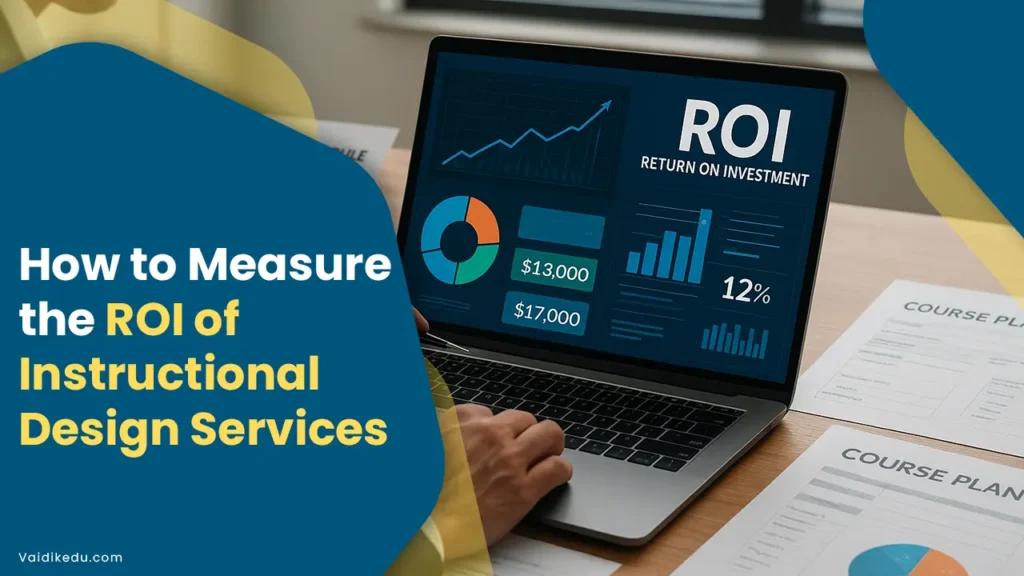Instructional design is the process of creating effective and engaging educational experiences by analyzing learners’ needs and developing tailored materials. By investing in instructional design services, organizations can enhance their training programs, leading to more skilled employees or learners.
ROI, or Return on Investment, helps measure the financial returns and overall impact of these training programs. It provides valuable insights into the effectiveness of training initiatives, enabling organizations to make informed decisions, prioritize high-impact programs, and justify budget allocations.
By continuously evaluating ROI, organizations can refine their instructional design services, ensuring alignment with business goals and contributing to organizational success.
When evaluating ROI in instructional design services, it’s essential to understand the different dimensions it encompasses. Immediate ROI captures the instant benefits seen right after training, such as a quick boost in productivity. Long-term ROI assesses the lasting impact on performance over time.
Financial ROI focuses on the monetary gains relative to the investment cost, evaluating profitability. Return on Learning (ROL) measures the improvements in employee skills, knowledge, and performance due to training.
Social ROI (SROI) evaluates the positive impact on society and the environment, often used by non-profits. Return on Investment in Innovation (ROII) focuses on the returns from investments in innovation and R&D.
Customer ROI looks at how initiatives like improved customer service translate into increased retention and revenue. Lastly, Employee ROI considers factors like increased productivity, reduced turnover, and enhanced employee engagement.
By understanding these varied aspects of ROI, organizations can better assess the comprehensive impact of their training investments.
Importance of ROI Evaluation For Instructional Design Services
Measuring the ROI of instructional design services provides essential benefits to organizations. It justifies training investments by demonstrating their value and securing ongoing support.
Understanding the effectiveness of training programs through ROI helps prioritize initiatives and allocate resources wisely. It identifies areas for improvement, enhancing the quality of training to better meet learner needs.
ROI assessments improve understanding of how training impacts financial performance, aiding in strategic planning and resource allocation. They also justify budget decisions with evidence-based support. ROI measurement ensures accountability, continuous improvement, and effective training outcomes.
Additionally, demonstrating positive training outcomes boosts employee motivation and engagement, leading to a more productive workforce. Overall, leveraging these benefits maximizes the impact and value of training programs, contributing positively to organizational success.
The Challenges of Measuring ROI For Instructional Design Services
Measuring the ROI of instructional design services involves several challenges. Intangible benefits like improved morale and job satisfaction are hard to quantify financially. Training effects may be delayed, making it difficult to link training directly to outcomes.
Varied learning curves among employees complicate assessments, while external factors like market conditions can skew results. Accurate data collection is time-consuming, and misalignment between training objectives and business goals can lead to discrepancies.
Quantifying soft skills and allocating costs, including hidden ones, add to the complexity. Standardization issues and tracking long-term effects also present challenges.
Tackling the Challenges of Measuring ROI for Instructional Design Services
To tackle these challenges, organizations can gather structured feedback to understand intangible benefits, use continuous evaluation to monitor long-term impacts and implement personalized learning plans.
Control groups and statistical methods can isolate training impact from external factors. Utilizing Learning Management Systems (LMS) and performance management software ensures accurate data collection. Aligning training objectives with business goals using SMART goals helps maintain consistency.
Behavioral assessments and peer reviews can measure soft skills improvements, while detailed expense tracking aids cost allocation. Standardized templates and industry benchmarks improve ROI calculations, and regular follow-up assessments enhance long-term effectiveness.
By addressing these challenges, organizations can make informed, data-driven decisions to optimize their training programs.
Guidelines For ROI Measurement
1. Define Clear Objectives: Start by defining specific and measurable objectives for your training program. Clearly articulate what success looks like to ensure precise measurement.
2. Learning Assessment: Conduct a baseline assessment before the training begins to establish a benchmark for comparison.
3. Quantifiable Metrics: Identify and track quantifiable metrics aligned with your training goals, such as increased sales, improved productivity, reduced errors, or enhanced customer satisfaction.
4. Cost Analysis: Assess the total expenses associated with the training program, including development, delivery, and the time invested by participants.
5. Post-Training Assessment: After the training, conduct assessments to measure the extent to which learning objectives were met. Use quizzes, surveys, or practical evaluations.
6. Performance Metrics: Connect training outcomes to performance metrics. Assess changes in KPIs directly influenced by the training, providing a tangible link between the program and organizational success.
This structured approach ensures a comprehensive evaluation of ROI in learning and development, despite the inherent complexities.
ROI evaluation methodology
There are several methods for evaluating the ROI of instructional design services.
Kirkpatrick’s Four Levels of Evaluation
Kirkpatrick’s evaluation model has stood the test of time for over seven decades, and for good reason. It’s a comprehensive method that helps determine whether training has achieved its intended outcomes. Kirkpatrick’s evaluation levels are
Level 1: Reaction
This level assesses how satisfied learners are with the training. Gathering this feedback helps ensure the training meets learners’ immediate needs and sets the stage for deeper learning.
Level 2: Learning
This level focuses on whether learners have acquired the intended knowledge and skills. This is typically measured through tests or assessments conducted before and after the training.
Level 3: Behavior
This level examines if learners are applying what they’ve learned on the job. It looks at behavior change and the implementation of new skills or knowledge in the workplace.
Level 4: Results
The final level measures the impact of the training on organizational performance. Did the training help achieve business goals or solve specific performance issues?
Use if you want a comprehensive evaluation of training effectiveness from reaction to results.
Great for understanding learner satisfaction, knowledge gain, behavior change, and overall impact on organizational performance.
Phillips ROI Methodology
The Phillips ROI methodology builds on Kirkpatrick’s model by adding a fifth level to measure the financial impact of training.
Level 5: ROI
This level converts training outcomes into monetary terms, providing a clear, quantifiable measure of ROI.
It is calculated by
ROI (%)=(Net Program BenefitsProgram Costs)×100
Here Net Program Benefits are the financial gains from the training, such as increased revenue or cost savings, and Program Costs are all expenses related to developing and delivering the training program.
Ideal if you need to quantify the financial impact of training.
Builds on Kirkpatrick’s model by adding ROI as a fifth level, making it useful for securing stakeholder support with clear, monetary benefits.
Benefit-Cost Ratio (BCR)
The benefit-cost ratio (BCR) is a simpler alternative to the Phillips ROI methodology. It’s calculated as:
BCR=Total BenefitsTotal Costs
A BCR of one or higher indicates that the training can be considered successful. While easier to calculate than Phillips ROI, BCR faces similar challenges, including difficulty capturing the long-term value of training due to its timeframe-based equation.
Training Performance Analysis (Pre And Post)
Pre-training data is collected over a set period, such as one month, and post-training data is gathered over another month. Comparing these metrics reveals performance improvements.
This method is simple and easy to implement, but timing is crucial. Measuring too soon may miss the training’s full impact while waiting too long could introduce external factors.
Control Group Comparison
In this method, a trained group is compared to a control group that did not receive training. For example, 50 retail employees undergo training while another 50 do not. Comparing performance metrics between the groups after training helps assess improvements.
The control group serves as a baseline, accounting for external factors like seasonal trends or economic conditions. However, this method can raise fairness concerns, and assembling comparable groups can be challenging.
Time To Proficiency
This method tracks how long it takes for individuals to reach desired proficiency levels after training, useful for new teams or roles. Pre-training metrics are tracked, and post-training performance is monitored regularly.
This approach aids workforce planning by providing data on staffing levels, timelines, and resource allocation. However, prioritizing speed over quality may lead to basic competence rather than long-term skill development and does not account for individual learning curves.
Customer Satisfaction And Feedback
Post-interaction surveys provide real-time feedback on areas needing improvement, helping tailor training programs. However, customer satisfaction is influenced by factors beyond staff interactions, such as pricing or product issues, which can affect feedback. Additionally, customers’ experiences are subjective, potentially skewing results.
Competency Mapping
Competency mapping assesses leadership and soft skills training by evaluating specific skills or competencies. Competencies are categorized into core, technical, and leadership competencies.
A competency matrix is developed, listing each competency and proficiency level, and individuals are assessed before and after training.
These methods provide various ways to measure the effectiveness and ROI of instructional design services.
By selecting the appropriate method and considering the specific context of your training program, organizations can gain valuable insights and make informed decisions about their training investments.
Key Metrics And Factors For Evaluating ROI of Training Programs
Measuring the ROI of instructional design services involves tracking a combination of tangible and intangible metrics for a comprehensive view of training effectiveness. Here are key factors, metrics, KPIs, and parameters to consider.
Tangible Metrics
- Training Costs: Includes expenses for needs assessment, design, development, implementation, evaluation, facilities, travel, and accommodation.
- Completion Rate: The percentage of learners who successfully complete the training.
- Employee Retention: The rate at which employees stay with the company post-training.
- Post-Training Survey: Feedback from participants on training relevance, clarity, and usefulness.
- Customer Satisfaction Levels: Changes in customer satisfaction due to training.
- Financial Savings: Savings from streamlined processes or reduced errors.
- Time Saved: Time saved using a new system or application because of the training.
- Performance Scores: Learners’ performance scores before and after training.
- New Employee Processing Time: Time taken to onboard new hires.
- Incident Reports or Customer Complaints: Number of reports or complaints before and after training.
- Closed Sales/Signed Contracts: Number of sales closed or contracts signed after training.
- Participation Rates: Participation rates in learning programs.
- Retention And Attrition Rates: Rates at which employees remain or leave the company.
Intangible Metrics
- Improvement in Performance: The extent to which learners feel the training helped improve their performance.
- Confidence Levels: How much more confident learners feel about performing job tasks post-training.
- Job Satisfaction: Learners’ job satisfaction after training.
- Commitment To The Organization: Employees’ commitment to their organization, department, team, and manager.
- Improvements in Teamwork, Customer Service, and Conflict Resolution: Observable improvements in these areas post-training.
- Skills Application: The extent to which learners use the skills they learned in training on the job.
Performance Metrics And KPIs
To measure the effectiveness and ROI of instructional design services, consider these KPIs:
- Cost Savings: Measures the reduction in costs due to decreased need for additional training sessions, lower dropout rates, and fewer rework incidents.
- Improved Productivity: Tracks the increase in employee productivity and job performance resulting from faster learning and higher proficiency.
- Enhanced Employee Retention: Monitors the rate of employee retention, reflecting the impact of training on job satisfaction and turnover rates.
- Quality And Consistency: Assesses the consistency and quality of work across employees, ensuring that everyone receives the same level of training and performs consistently.
- Scalability And Flexibility: Evaluate how easily training programs can be updated and scaled to meet changing technology, processes, or organizational goals, ensuring long-term effectiveness.
- Employee Performance Improvement: Track improvements in performance metrics.
- Behavioral Changes: Observable changes in behavior and work practices post-training.
- Business Impact Assessment: Specific business outcomes influenced by training, such as increased sales, improved product quality, or enhanced customer satisfaction.
By focusing on these factors, metrics, and KPIs, organizations can effectively measure the ROI of their instructional design services and make data-driven decisions to optimize their training programs.
Conclusion
Measuring the ROI of instructional design services is essential for optimizing training programs. By tracking tangible and intangible metrics, organizations gain a comprehensive understanding of training effectiveness.
Using evaluation techniques like Kirkpatrick’s Four Levels of Evaluation, Phillips ROI Methodology, and Benefit-Cost Ratio (BCR) and others, helps assess learner satisfaction, knowledge gain, behavior changes, and business impact in financial terms.
Focusing on KPIs such as cost savings, improved productivity, and employee retention ensures effective training and justifies investments. Continuous evaluation and refinement drive long-term success, aligning training with organizational goals.
Frequently Asked Questions
Involve key stakeholders to define specific, measurable objectives using the SMART criteria (Specific, Measurable, Achievable, Relevant, Time-bound). This ensures that training goals align with organizational needs and provide a clear benchmark for evaluation.
Use a combination of pre-and post-training assessments, surveys, performance metrics, and cost analysis. Tools like Learning Management Systems (LMS) and performance management software can help automate and standardize data collection, making it easier to analyze and compare results.
Involve stakeholders in setting training objectives and use data to regularly review and adjust programs. Ensure that training content addresses the specific skills and knowledge required to meet organizational goals.









